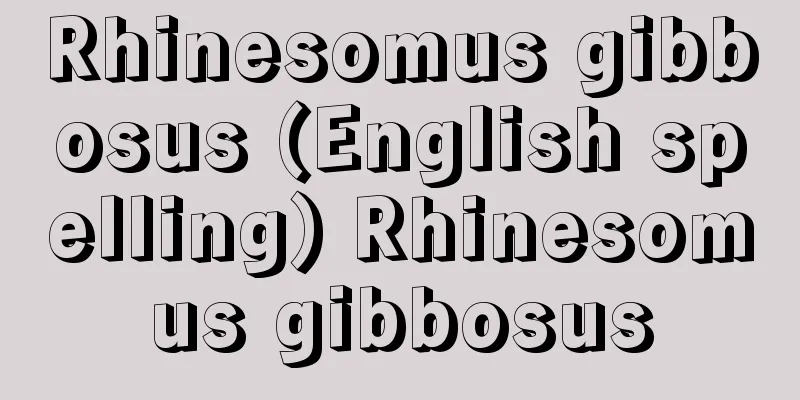Washington Convention

|
A treaty aimed at protecting wild fauna and flora whose survival is threatened by international trade. Its official name is the Convention on International Trade in Endangered Species of Wild Fauna and Flora. It is abbreviated as CITES. This treaty is called the Washington Convention because it was adopted at an international conference held in Washington in 1973. It came into force in 1975. At the time, Japan was one of the world's leading importers of wild fauna and flora and processed products, so there was a demand for it to join early, but it took time to put in place domestic laws, and Japan only became the 60th country to sign the treaty in 1980. As of 2013, there are 178 signatory countries. Despite being on the brink of extinction, the trade of wild plants and animals, as well as products made from them, is on the rise worldwide. Unchecked overhunting and what appears to be excessive trade are steadily reducing animals and plants from the wild. The Convention on International Trade in Endangered Species of Wild Fauna and Flora (CITES) is an international treaty that aims to protect wildlife from extinction or the threat of extinction by regulating international trade. Species that are highly endangered are divided into appendices I, II, and III, and the text specifies in detail the species that are specifically regulated, restricting imports and exports. Appendix I is a strict treaty that effectively prohibits import and export trade, but if a signatory country makes a reservation for a particular animal or plant, that species is treated as an exception to the treaty. As of 2013, Japan has reservations for seven whale species in Appendix I and nine species, including sharks in Appendix II. The loophole of reservations allows exceptions even for species that are otherwise prohibited from commercial trade. This raises the risk that reservations will continue for domestic gain, and that nature conservation policies of the country of origin for species protected by the treaty will be ignored. Reservations remain the most serious problem facing CITES. Furthermore, there is the problem that restrictions on import and export trade under the Washington Convention and the Foreign Exchange and Foreign Trade Act are not enough to restrict domestic distribution of illegally traded goods. For this reason, the Act on Regulation of Domestic Trade in Rare Wild Fauna and Flora (Transfer Act, officially the Act on Regulation of Transfer of Endangered Wild Fauna and Flora), which restricts (prohibits) domestic buying and selling, was enacted and came into effect in 1987 (Showa 62). The transfer regulation act was subsequently amended, and the Act on Conservation of Endangered Species of Wild Fauna and Flora (Species Conservation Act) was enacted in 1992 (Heisei 4). The Transfer Act was absorbed into the Species Conservation Act. This law states how important wildlife is, stating, "In light of the fact that wild fauna and flora are not only important components of the ecosystem, but also an important part of the natural environment, and are indispensable to the rich lives of human beings, the purpose of this law is to conserve the natural environment by conserving endangered species of wild fauna and flora, thereby contributing to ensuring a healthy and cultured life for the people of today and the future." It also states, "Comprehensive measures for the conservation of endangered species of wild fauna and flora shall be formulated and implemented," so many people hoped that with the Washington Convention and this Species Conservation Law, wildlife species would be protected even more than before. The Species Conservation Law specifically designates each species that is at risk of extinction in Japan, and then regulates the capture, transfer, import and export of those species. The Species Conservation Law covers a wider range of matters than the Transfer Law, including the development of habitats for designated wildlife species. Not only live animals and plants, but also stuffed specimens, specimens, and bird eggs are subject to regulation. Penalties are also imposed for any violation of the regulations. The treaty's appendix includes species that are not necessarily at risk of extinction, and some argue that it is wrong to regulate them. However, some countries argue that the effectiveness of protection will increase if species that are at risk of extinction are also included in the appendix. Each species that is added to or removed from the appendix is discussed at the Conference of the Parties, which meets every two years. The Conference of the Parties not only aims to protect wild fauna and flora by prohibiting or strengthening regulations on the capture, transfer, import and export of species listed in the Appendices, but also plays an important role in coordinating opinions on the use of species that have been saved from extinction and increasing populations, while working to conserve and promote sustainable use of species in line with the spirit of the Convention. Furthermore, one of the features of this conference is that non-governmental organizations (NGOs) can participate in the conference. One of them is TRAFFIC (the wildlife trade monitoring network). TRAFFIC is an international network that monitors and advises on the international trade of wild animals and plants and products made from them, and is an organization that can learn about the entire CITES. Its headquarters are in the UK and it has 26 offices around the world. It has an inseparable relationship with WWF (World Wildlife Fund) and IUCN (International Union for Conservation of Nature), and it verifies statistical data on international trade, grasps and analyzes trends in trade, and prepares reports for governments and private organizations. It plays the role of the so-called CITES G-men, who washes smuggled goods that violate the treaty and marks unscrupulous traders. TRAFFIC's significance is in pursuing the actual situation regarding conservation, not just pretenses, of various issues surrounding the CITES that are difficult to see. Although the CITES is an intergovernmental treaty, environmental protection organizations such as TRAFFIC are allowed to participate and speak at the Conference of the Parties. When the Conference of the Parties decides whether to regulate the species and relax regulations from Appendix I to Appendix II, or strengthen regulations from Appendix II to Appendix I, TRAFFIC can speak, although it does not have voting rights. This allows citizen-level voices to be reflected and has a great influence on votes. [Nobuo Kase] African elephant problemAt the 1989 conference, the African elephant was elevated from Appendix II to Appendix I. Initially, southern African countries (Zimbabwe, Botswana, and Namibia) insisted on Appendix II, which requires trade with permission, on the grounds that African elephants are their natural economic resource, while Western countries repeatedly insisted on upgrading to Appendix I. Both proposals were rejected, and the proposal ran into a deadlock. In the end, the African elephant was placed on Appendix I, but the proposal was resolved by establishing a special review method for local populations with a low risk of extinction to be reverted to Appendix II in the future by the next conference. As a result, at the Kyoto Conference in 1992, southern African countries argued that African elephants are a population that can be used sustainably, and that they cannot be protected unless the costs of poaching prevention and other costs are covered through ivory trade, and reserved the African elephant when concluding the treaty. This caused strong opposition from Western countries, who considered the African elephant, the largest animal on earth, a symbol of nature conservation and believed that trade should be completely banned. In addition, southern African countries requested and proposed that the African elephant be downlisted from Appendix I to Appendix II, but the proposal was not adopted and the status quo was maintained. However, at the Harare Conference in 1997, this issue, which had been pending since the Kyoto Conference, was resolved by moving the elephant from Appendix I to Appendix II, reducing the strictness of regulations. Thus, ivory trade was resumed, albeit on a limited scale. The African elephant raises the issue of the limitations of the treaty, which requires sustainable use and adherence to the treaty, in order to protect ecosystems and wildlife. [Nobuo Kase] [Reference] | Act | |Source: Shogakukan Encyclopedia Nipponica About Encyclopedia Nipponica Information | Legend |
|
国際取引によって生存を脅かされている野生動植物の保護を目的とする条約。正式には「絶滅のおそれのある野生動植物の種の国際取引に関する条約」(Convention on International Trade in Endangered Species of Wild Fauna and Flora)。略称CITES(サイテス)。この条約は、1973年にワシントンで開かれた国際会議で採択されたために「ワシントン条約」とよばれる。発効は1975年。当時の日本は世界有数の野生動植物とその加工品の輸入国であったため早期加入が求められていたが、国内法の整備に時間がかかり、1980年(昭和55)に60番目の締結国となった。2013年時点で、締結国は178か国。 絶滅の危機に瀕(ひん)しているにもかかわらず野生動植物あるいはそれらを加工した製品の売買は、世界的に増える傾向にある。野放図(のほうず)な乱獲や過剰とも思える取引は野生から動物や植物を次々と減らしていく。ワシントン条約は国際的取引を規制することによって、野生生物を絶滅からあるいは絶滅のおそれから守ろうとする国際条約である。絶滅の程度の高いものから付属書の形でⅠ、Ⅱ、Ⅲに分けられ、文中で具体的に規制する種を細かく定め、輸出入を規制している。 付属書Ⅰは、事実上輸出入の取引ができない厳しいものだが、締結国は特定の動物や植物について留保すれば、その種に限り条約非締結として除外扱いされる。日本は、2013年(平成25)時点で、付属書Ⅰのクジラ7種と付属書Ⅱのサメなど9種が留保扱いとなっている。留保という抜け穴によって、本来商取引が禁じられている種の取引であっても例外扱いとなる。これにより、国内の利益のために留保を継続し、条約によって保護されている原産国の種の自然保護政策をないがしろにしてしまうおそれがある。留保はワシントン条約にみられる諸問題のなかでもっとも深刻なものとしていまも残っている。 また、ワシントン条約や外国為替(かわせ)及び外国貿易法(外為(がいため)法)などによる輸出入の取引規制だけでは、不法に取引されたものについての国内流通は規制できないという問題がある。このため、国内での売買を規制(禁止)する希少野生動植物の国内での取引の規制法(譲渡法。正式には「絶滅のおそれのある野生動植物の譲渡の規制等に関する法律」)が制定され、1987年(昭和62)に施行された。その後譲渡の規制に関する法律は改められ、1992年(平成4)に「絶滅のおそれのある野生動植物の種の保存に関する法律」(種の保存法)が成立した。譲渡法は種の保存法のなかに吸収された。 この法律では、「野生動植物が、生態系の重要な構成要素であるだけでなく、自然環境の重要な一部として人類の豊かな生活に欠かすことのできないものであることに鑑(かんが)み、絶滅のおそれのある野生動植物の種の保存を図ることにより良好な自然環境を保全し、もって現在及び将来の国民の健康で文化的な生活の確保に寄与することを目的とする」と、野生生物がいかに大切であるかが書かれている。そして「絶滅のおそれのある野生動植物の種の保存のための総合的な施策を策定し、及び実施するものとする」とも書かれているので、「ワシントン条約」とこの「種の保存法」とで、多くの人たちが野生生物の種は、これまで以上に守られると期待した。 種の保存法では、日本国内で絶滅のおそれのある、それぞれの種を具体的に指定し、そのうえで捕獲、譲渡、輸出入にかかわることを規制した。種の保存法は、指定された野生生物の種の生息地の開発などを含め、譲渡法よりいっそう広い範囲をカバーする法律となっている。それらについては生きた動植物だけではなく、剥製(はくせい)や標本、鳥類の卵も規制の対象となる。また規制に違反した場合には罰則が課せられる。 条約の付属書には、かならずしも絶滅のおそれの大きくない種までも加えられているため、それらを規制するのはおかしいという議論も起こっている。しかし、絶滅のおそれのある種に限らず「絶滅予備軍」の種も規制の対象としてこそ保護の有効性は増すと主張する国々もある。付属書に新たに加えられたり、削除される種のそれぞれについては、2年に一度開かれる締結国会議で討議されていく。 付属書に記載されている種の捕獲、譲渡、輸出入の禁止あるいは規制の強化で、野生動植物の保護を図るだけでなく、条約の主旨に沿い、種の保全と持続可能な利用(サスティナブル・ユース)までを図りながら、絶滅の危機が回避された種や増加している個体群の利用についての意見調整をするのも、締結国会議の重要な役割となっている。 またそのうえに、この会議の特色の一つは、非政府組織(NGO)の自然保護団体が参加できることにある。その一つにトラフィックTRAFFIC(野生動植物国際取引調査記録特別委員会the wildlife trade monitoring network)がある。トラフィックは、野生の動物や植物およびそれらを原料とする製品の国際取引に目を光らせモニター(勧告)するための国際的なネットワークで、ワシントン条約の全体を知ることができる組織である。本部はイギリスに置かれ、世界各地に26のオフィスがある。WWF(世界自然保護基金)とIUCN(国際自然保護連合)とは不即不離の関係にあり、国際取引の統計データを検証し、取引の動向をつかみ分析し、政府や民間機関への報告書をつくる。条約に違反する密輸品を洗い悪徳業者をマークする、いわゆるワシントン条約のGメンの役割を担っている。ワシントン条約をめぐる、表に現れにくいさまざまな事柄を、たてまえでなく、保護に関する実態を追求していくことにトラフィックの意義はある。 ワシントン条約は政府間の条約であるにもかかわらず、トラフィックをはじめ環境保護団体の締結国会議への参加と発言が認められている。その種を規制し、付属書のⅠからⅡへと規制を緩めるか、ⅡからⅠへ規制を強めるかなどを締結国会議で決めるとき、トラフィックは議決権はないが発言できる。そこに市民レベルの声が反映され、表決にも大きな影響力をもってくる。 [加瀬信雄] アフリカゾウ問題1989年の会議ではアフリカゾウが付属書Ⅱの種からⅠに格上げされた。当初南部アフリカ諸国(ジンバブエ、ボツワナ、ナミビア)はアフリカゾウを自国の自然経済資源だとする立場から許可制取引の付属書Ⅱを主張し、一方で欧米諸国は付属書Ⅰへの格上げの主張を繰り返した。両案とも否決され議案は暗礁に乗り上げてしまった。結局アフリカゾウは付属書Ⅰの動物とするが、絶滅の危機の少ない地域個体群については将来付属書Ⅱに戻すための特別な検討方法を、次回会議までに確立することで提案は決着された。その結果、1992年の京都会議において、アフリカゾウは持続可能な利用を図るに足る個体群であり、象牙(ぞうげ)の取引などを通じて密猟防止その他にかかる費用を得なければ保護はできないと南部アフリカ諸国は主張し、条約締結に際しアフリカゾウを留保した。このため、地上最大の動物アフリカゾウを自然保護のシンボルとして、取引は全面禁止で当然とする欧米諸国は激しく反発した。また、南部アフリカ諸国はアフリカゾウを付属書ⅠからⅡへ格下げするよう要求、提案したが、採択は見送られ、現状維持となった。しかし、1997年のハラレ会議では、京都会議に続き懸案であったこの問題を、付属書のⅠからⅡへと移し、規制の厳しさを減らすことで解決した。そして限定的だが象牙の取引は再開されることになった。 持続可能な利用を図りながら条約を遵守する。そのうえで生態系と野生生物を守るためには、この条約に限界があることをアフリカゾウは問題提起しているといえる。 [加瀬信雄] [参照項目] | | |出典 小学館 日本大百科全書(ニッポニカ)日本大百科全書(ニッポニカ)について 情報 | 凡例 |
>>: Henry Rossiter Worthington
Recommend
hyaloid membrane
…It is 99% water (vitreous humor), with a small a...
Mummy (mummy) - mummy (English spelling)
A tenable corpse. A corpse that has remained almos...
Kineya Yajuro (first generation)
...Lyrics by Fujimoto Tobun. Music by the first K...
Reverse discrimination
Affirmative action, which was introduced in the Un...
Wood rose - Kibara
…So, rather than sticking to the traditional syst...
Banker's acceptance - ginkou hikiukete gata (English spelling)
A term bill of exchange that is signed and accepte...
Favela (English spelling)
A slum area in large Brazilian cities and suburbs,...
Nkole
...a kingdom in Uganda, East Africa. In 1898, the...
Uji River
A midstream river in the Yodo River system. The S...
Lord of the Amazon
…A non-venomous snake of the Boidae family, known...
Monkiageha (English spelling) Red Helen
A butterfly belonging to the family Papilionidae ...
Shugoro Yamamoto - Yamamoto Shugoro
Novelist. Born on June 22, 1903, in Shimo Hatsuka...
Jacobin Club (English name) Club des Jacobins
A political association formed by members of the B...
Brunfelsia latiforia (English name) Brunfelsia latiforia
…[Kazuo Furusato]. … *Some of the terminology tha...
Castellion - Sébastien Castellion
French theologian. He fled to Geneva and taught c...









